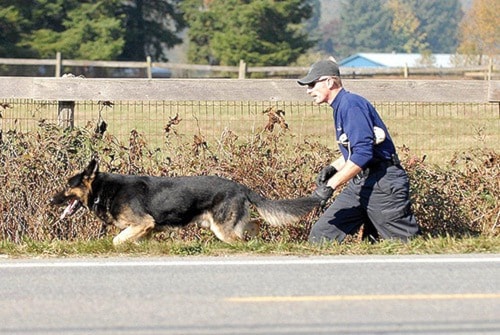A new report from Pivot Legal Society lists Abbotsford as having the second highest number of police-dog bites in B.C., next to Vancouver.
The report, titled "Moving Toward Minimum Force: Police Dogs and Public Safety in British Columbia," was released Thursday.
According to a press release from Pivot, the report compiles more than two years of provincial police data, detailing the deployment of police service dogs and the outcome.
The report states that, on average, a person in B.C. is bitten by a police dog every other day.
Between 2010 and 2012, there were 490 people bitten and injured by police dogs, Pivot says. Many of the dog bites led to serious and permanent injury, according to the report.
"Unlike other police impact weapons such as fists and batons, police dogs are unique in their tendency to inflict devastating and permanent damage," said Pivot lawyer Douglas King, author of the report.
"We should not be viewing them as friendly ambassadors of policing, but as potentially deadly weapons."
Vancouver's "bite rate" was the highest, with 14.75 per 100,000 people, and Abbotsford's was second with a rate of 12.73.
King said these numbers were "disproportionately higher" than the eight other areas listed on the report. Third on the list was the "north" area with a rate of 5.38.
Abbotsford Police Const. Ian MacDonald said one reason Abbotsford might have higher numbers than other areas is because of its high deployment of police dogs in the farmland near the U.S. border.
Border jumpers crossing into Canada often end up hiding on farmland, such as large berry fields, making them difficult to track down without the use of a police dog, MacDonald said.
"It's not like in the downtown core where you can park (police) cars on every corner, waiting to spot the person."
A higher deployment of police dogs in Abbotsford means a greater likelihood that the bite rate will be higher, he said.
MacDonald relayed the story of a father and son from Central America who jumped the border and were tracked to a berry field. The father gave himself up right away, but a dog was deployed to find the son, who ended up with a minor dog bite, MacDonald said.
"One of the things the dad said was, 'That's why I don't hide.' "
The Abbotsford Police Department (APD) is part of the RCMP's Lower Mainland Integrated Police Dog Services, which is composed of 39 handler/dog teams from the RCMP and four from the APD.
Any of the teams can be deployed to any participating community at any time. When they are not on a call, they patrol the communities in which they are based and provide backup to general duty officers.
All are trained through the same program.
The Pivot report proposes a series of recommendations that include restrictions on how the dogs can be deployed and changes to the way dogs are trained.
The ministry of the attorney general has set up the Police Dog Working Group, which is in the process of finalizing provincial standards on the deployment of police dogs.
"Police dogs are an important, effective policing tool – but like any tool, they must be used consistently and effectively," Attorney General and Minister of Justice Suzanne Anton told Black Press.
